

County Extension Office
Post Office Box 1286
Conway, Arkansas 72032
HOME AND GARDEN BULLETIN No. 106
UNITED STATES DEPARTMENT OF AGRICULTURE
This is a Consumer Service of USDA
Washington, D.C.
Issued February 1966
Slightly revised October 1972
For sale by the Superintendent of Documents, U.S. Government Printing Office
Washington, D.C. 20402—Price 15 cents
Stock Number 0100-2612
Prepared by
CONSUMER AND FOOD ECONOMICS INSTITUTE
Agricultural Research Service
Fresh, wholesome meats and fresh, wholesome poultry are suitable for home canning. Frozen meats also may be canned at home.
Popular meats for home canning are—
Meat and poultry canned at home must be processed in a pressure canner. Either glass jars or tin cans may be used for home canning.
To insure the safety and wholesomeness of the meats you can at home—
Acknowledgment is made to the research laboratories of the National Canners Association for consultation and advice on processing.
Follow all canning directions carefully. Processing times and temperatures were developed specifically for use with a pressure canner.
Meat may contain bacteria that cause botulism, a severe form of food poisoning. These bacteria are destroyed when cans or jars of food are processed at a temperature of 240° F. for the times specified.
There is a risk of botulism from home-canned meats if the processing temperature is lower than 240° F. or if processing time is shorter than recommended.
It is not safe to process canned meat in a boiling-water bath, an oven, a steamer without pressure, or an open kettle. None of these methods will heat the meat enough to kill dangerous bacteria in a reasonable time.
There also is a risk of botulism if shortcuts are taken in canning meats, if untested directions are used, or if processing times (pp. 18 to 23) are changed.
Use only good-quality meat or poultry—home-produced or purchased from a farm or store.
Chill home-produced meat immediately after slaughter to prevent spoiling and to permit tenderizing. Meat is easier to handle when it is cold. For thorough chilling, keep meat at a temperature below 40° F. until time to prepare it for canning; can it within a few days after slaughter.
If refrigeration is not available and if the maximum daily temperature is above 40° F., process the meat as soon as body heat is gone.
If meat must be held for longer than a few days, freeze it. Store frozen meat at temperatures of 0° F. or lower until canning time. Then cut or saw frozen meat into pieces of desired size.
If frozen meat is thawed before canning, thaw it in a refrigerator at a temperature of 40° F. or lower until most of the ice crystals have disappeared.
Keep all meat clean and sanitary. Rinse poultry thoroughly in cold water, then drain.
Keep all meat as cool as possible during preparation for canning. Handle it rapidly; process it as soon as containers are packed.
To control the bacteria that cause spoilage, keep everything that touches meat as clean as possible.
Scrub metal, enamelware, and porcelain pans in hot soapy water. Rinse pans well in boiling water before putting meat in them. Wash knives and kitchen tools to be used in canning; rinse well with boiling water.
Cutting boards, wood utensils, and wooden work surfaces need special treatment to keep spoilage bacteria under control. Scrape surfaces if necessary; scrub with hot soapy water and rinse well with boiling water. Then disinfect clean surfaces.
For disinfecting, use a liquid chlorine disinfectant (household laundry bleach) or other disinfectant. Dilute according to directions on the container. Cover wooden surfaces with the disinfectant solution and leave 15 minutes. Wash solution off with boiling water.
To insure the safety of canned meats and poultry, jars or cans must be processed at a sufficiently high temperature for a long enough time to kill all bacteria that cause spoilage or food poisoning.
The only practical way to get this high temperature is to use a pressure canner. When steam is held under 10 pounds of pressure at sea level, the temperature in the canner quickly reaches 240° F.—the necessary safe temperature for canning meat.
A pressure canner should be equipped with a rack to hold jars or cans.
A pressure saucepan with accurate controls may be safely used for processing meats in pint jars or No. 2 cans. If you use a pressure saucepan, add 20 minutes to the processing times specified.
Before using the canner, wash the kettle well. Do not put cover with dial gage in water. Wipe the cover carefully with a hot soapy cloth; repeat with a clean damp cloth. Dry. Keep the petcock and safety valve clear. Before each use of the canner, inspect these openings. To clean, draw a string or narrow strip of cloth through the petcock.
Pressure adjustments.—If you live above sea level, you may need to adjust steam pressure in your canner to get a temperature of 240° F. The rule: For each 2,000 feet above sea level, increase the pressure by 1 pound.
Caution: Do not increase processing time when you increase steam pressure.
If a weighted gage is used at a high altitude, have it corrected for altitude by the manufacturer of the canner.
Gage adjustments.—When a weighted gage is adjusted for altitude, it needs no further regulation.
A dial gage should be checked before the canning season. If you use the 6 canner frequently, have the gage checked several times a year. Ask your extension home economist, your dealer, or the manufacturer about checking the accuracy of a dial gage.
If the dial gage is not accurate, tie a warning tag to the canner. On the tag, write the margin of error, the date the canner was tested, and the gage setting to use for the correct pressure (see below).
All directions in this bulletin require processing at 10 pounds of steam pressure. The following adjustments give the correct pressure:
If the gage reads high—
1 pound high—process at 11 pounds.
2 pounds high—process at 12 pounds.
3 pounds high—process at 13 pounds.
4 pounds high—process at 14 pounds.
If the gage reads low—
1 pound low—process at 9 pounds.
2 pounds low—process at 8 pounds.
3 pounds low—process at 7 pounds.
4 pounds low—process at 6 pounds.
It is not safe to use a canner if the dial gage registers as much as 5 pounds high or low. Replace a faulty gage with an accurate one.
Jars may be widemouth or regular type. Pints and quarts are satisfactory sizes for canning meats and poultry.
There are two types of jar closures:
Be sure all jars and closures are perfect. Discard jars with cracks or chips; discard lids and bands with dents or rust. Defects prevent air-tight seals.

Before canning, jars must be thoroughly clean. It is not necessary to sterilize them before they are filled, however. Processing at the recommended steam pressure sterilizes both the containers and their contents.
Wash jars and lids in hot soapy water; rinse well. Some metal lids with sealing compound may need boiling or holding in boiling water for a few minutes before use. Do not reuse metal lids with sealing compounds. Follow the manufacturer’s directions.
If you use rubber rings, get new ones of the right size to fit jars. Don’t test by stretching. Wash rings in hot soapy water. Rinse well.
Use plain tin cans in good condition for canning meats.
C-enamel, R-enamel, and sanitary-enamel cans are not suitable for meat. Fat in meat or poultry may cause enamel to peel off the inside of the can. Meat in such cans appears unappetizing, but it is not harmful.
Make sure that cans, lids, and gaskets are perfect. Discard cans that are badly bent, dented, or rusty; discard lids with damaged gaskets.
Protect lids from dirt and moisture by storing them in original packing.
Directions are given for canning meat in No. 2 and No. 2½ tin cans. A No. 2 can holds 2½ cups; a No. 2½ can holds 3½ cups.
Wash cans in clean hot water just before use. Drain upside down.
Do not wash lids of cans, because washing may damage the gaskets. If lids have become soiled, rinse with clean water or wipe with a damp cloth when you are ready to put them on cans.
If you use cans, you need a sealer in good working order. Before processing meat or poultry, adjust sealer according to manufacturer’s directions.
The finished seam between lid and can should be smooth and even.
Test by sealing a can containing a small amount of water. Submerge the sealed can in boiling water for a few seconds. If air bubbles rise from around the can, the seam is not tight. Readjust the sealer.
It is a good idea to use a thermometer both when meat is packed hot and when the canning directions call for removing (exhausting) air from jars or cans. With a thermometer, you are able to make sure meat is heated to 170° F.—the minimum temperature needed to exhaust air properly.
Place thermometer in center of jar or can that is being heated. The thermometer bulb should be about half-way to the bottom of the container.
If a thermometer is not available, follow the times given in the directions.

76627—B
For hot pack, pour boiling liquid over packed poultry or meat before closing jar and processing
in a pressure canner.
Prepare and process meat and poultry according to general directions given. Directions specify the types of packs and types of containers suitable for each meat product listed. Instructions must be followed carefully to assure a product safe from spoilage.
Detailed directions for canning meats are given on pages 18 to 20. Picture sequences are shown on pages 14 and 15.
Detailed directions for canning poultry are given on pages 21 to 23. Pictures illustrating main steps are on pages 16 and 17.
To make meat or poultry broth, place bony pieces in saucepan and cover with cold water. Simmer until meat is tender. Pour broth into another pan; skim off fat. Add boiling broth to containers packed with precooked meat or poultry; fill to level specified in directions.
Pack meat loosely in containers. Jars may lose liquid during processing if they are packed too tightly or too full.
Work with one glass jar or tin can at a time. Keep precooked meat hot while packing. Use boiling liquid—broth, meat juice, or water—if directions call for added liquid.
Two methods are used for packing meat:
• Hot pack. Meat is precooked before it is packed in jars or cans. Boiling broth or boiling water is poured over meat before containers are processed in a pressure canner. (See p. 8 for directions on how to make broth.) The temperature of food packed hot should be at least 170° F. at the time jars are closed or cans are sealed.
• Raw pack. Meat is packed uncooked. Raw-packed meat usually is heated to 170° F. to exhaust—or remove—air from jars or cans before processing in a pressure canner.
Directions for canning in glass jars require exhausting air from raw-packed meat products, except meat-vegetable stew and raw pack poultry, with bone. These two products may be processed without exhausting if they are raw packed in glass jars according to directions on pages 20 and 22.
Directions for using tin cans include exhausting air from all raw-packed meat. It always is necessary to exhaust air from raw-packed meat in tin cans before processing because air has no way to escape after cans are sealed.
To exhaust—or remove—air, set open jars or cans packed with raw meat on a rack in a large pan of boiling water. Water level should be about 2 inches below tops of jars or cans. Cover the pan. Cook meat in containers at slow boil until temperature at center of jars or cans registers 170° F. If a thermometer is not available, follow times given to cook meat until medium done.
When raw-packed meat is heated to 170° F., air is driven out of the food so that a vacuum will be formed in jars or cans after processing and cooling. Exhausting air also helps to prevent changes in the flavor of canned meat.
Salt may be added to canned meat for flavor. It does not act as a preservative in canned meat, so it is not needed to make the product safe.
If you decide to use salt, add it after meat is packed in the jar or can. Amounts for various sized containers are given in the canning directions.
Remove as much fat as possible from meat before canning. Cut off all large lumps; trim marbled meat without slashing the lean unnecessarily.
Do not use excessively fat meat or poultry for canning.
After packing containers, wipe the tops free of fat. Any fat that gets on the rim of jars or cans may prevent an airtight seal.
If jar has a flat metal lid: Wipe rim of packed jar to remove fat and meat particles that might prevent a proper seal. Put lid on jar with sealing compound next to glass. Screw the metal hand down tight by hand. When band is screwed tight, this lid has enough “give” to let air escape during processing. Do not tighten band further after taking jar from canner.
If jar has a porcelain-lined zinc lid: Fit wet rubber ring down on shoulder of empty jar. Don’t stretch ring unnecessarily. Pack jar with meat. Wipe rubber ring and jar rim clean. Then screw cap down firmly and turn it back ¼ inch before processing. As soon as you take jar from canner, screw cap down tight to complete seal.
Use a can sealer in good working condition. Follow the manufacturer’s directions carefully.
Wipe rim clean; place lid on can. Seal at once.

PN-1327
A can sealer is needed if tin cans are used.
Use a pressure canner for processing meat. A pressure saucepan may be used for pint jars or No. 2 cans (see p. 5).
Follow the manufacturer’s directions carefully. Here are a few suggestions about using a pressure canner:
• Put 2 or 3 inches of water in the canner; heat to boiling. Use enough water to prevent the canner from boiling dry.
• Set packed jars or cans on rack in the canner. Allow space for steam to flow around each container. If there are two layers of cans or jars, stagger the top layer. Use a rack between layers of jars.
• Fasten canner cover securely so that all steam escapes through the petcock or weighted-gage opening.
• Let steam pour steadily from vent for 10 minutes to drive all air from the canner. Then close petcock or put on weighted gage.
• Let pressure rise to 10 pounds (240° F.). The moment this pressure is reached, start to count processing time. Regulate heat under the canner to maintain even pressure. Do not lower pressure by opening petcock. Keep drafts from blowing on canner. Fluctuating pressure during processing causes liquid to be drawn out of glass jars.
• Watch processing time carefully. When time is up, remove canner from heat immediately.
• If meat is packed in jars, let canner stand until pressure drops to zero. Do not pour cold water over canner. When pressure is reduced suddenly, jars lose liquid. After pressure registers zero, wait a minute or two. Then slowly open petcock or take off weighted gage. Unfasten cover and tilt the far side up so steam escapes away from you. Take jars from the canner.
• If meat is packed in cans, remove canner from heat as soon as processing time is up. Open petcock or take off weighted gage at once to release steam. Then unfasten cover, tilting far side up so steam escapes away from your face. Remove cans.
The number of jars or cans you get from a given amount of raw meat varies with the size of the pieces and the way the meat is packed.
For a 1-quart jar, allow approximately the following amounts of fresh, untrimmed meat with bone or ready-to-cook chicken:
| Beef: | Pounds | |
| Round | 3 to 3½. | |
| Rump | 5 to 5½. | |
| Pork loin | 5 to 5½. | |
| Chicken: | ||
| Canned with bone | 3½ to 4¼. | |
| Canned without bone | 5½ to 6¼. | |
As soon as you take jars out of the canner, complete seals if necessary.
Cool jars top side up. Put them on a rack or folded cloth to cool. Keep them away from drafts. Don’t cover.
When jars are cool, take off screw bands. Do not force bands that stick: loosen by covering them with a hot damp cloth. Wash hands and store them in a dry place.
As soon as you take cans out of the canner, put them in cold water. Change water frequently for fast cooling. Remove cans from water while they are still warm so they will dry in the air. If you stack cans, stagger them to allow air circulation.
Check containers for leaks when jars or cans are thoroughly cool.
Occasionally, a can packed too full bulges at the ends. Set it aside and use within a few days. This will prevent later confusion with cans that bulge from spoilage during storage.
On the day after canning, examine each jar carefully. Turn it partially over. If jar has a flat metal lid, test seal by tapping center of lid with a spoon. A clear ring means a good seal. A dull note, however, does not always mean a poor seal. Another test is to press on the center of the lid; jar is sealed if lid is down and does not move.
Examine seams and seals carefully on all cans. Can ends should be almost flat, with a slight inward curve. Buckled or broken seams may be caused by cooling cans too fast or by not filling cans with enough meat.
Do not store leaky jars and cans. Either use the food at once or can it again in another container. Begin the second canning by heating meat through. Then pack and process it in a pressure canner for the full time recommended.
Do not open and refill jars that have lost liquid during processing. Loss of liquid does not cause canned meat to spoil. Opening would contaminate the sterile contents, and meat would have to be processed again to insure safety.
Wipe containers after they are cool. Label each jar and can to show contents and date of canning. If you canned more than one lot on one day, add a lot number.
Select a cool, dry place for storing canned meat and poultry. Protect meat from heat, from freezing, and from dampness.
Heat causes canned foods to lose quality. Do not store canned meats in direct sunlight, near hot pipes, or near heat.
Freezing does not cause canned meat to spoil, but it may damage the seal so that spoilage begins. In an unheated storage area, cover jars and cans with a clean, old blanket or wrap them in newspapers.
Dampness may corrode cans or metal jar lids and cause leakage.
Immediately destroy any canned meat that has spoiled. Burn it or dispose of it where it cannot be eaten by humans or animals.
Do not taste canned meat that you suspect of being spoiled.
Take these positive steps to insure the safety of canned meat—
To avoid any risk of botulism—a serious food poisoning—it is essential that the pressure canner be in perfect order and that every canning recommendation be followed exactly. Unless you are absolutely sure of your gage and canning methods, boil home-canned meat 20 minutes in a covered pan before tasting or using.
Boiling is the best way to find out if canned meat is safe. Heat brings out the characteristic odor of spoiled meat. If meat develops such an odor, destroy it without tasting.
If boiled meat is not to be used at once, or if it is to be used in salads or sandwiches, refrigerate it immediately.
Be alert to signs of spoilage when you take meat containers from storage. Bulging jar lids or rings, gas bubbles, leaks, bulging can ends—these may mean the seal has broken and the food has spoiled. Test each can by pressing the ends; ends should not bulge or snap back.
Check the contents as you open the container. Spurting liquid, off-odor, and color changes in meats are danger signals.
Sulfur in meat often causes metal lids or cans to darken. This discoloration does not affect the safety of the meat.

PN-1311
1. Cut meat carefully from bone. Trim away
most of fat without unduly slashing the lean
part of meat.
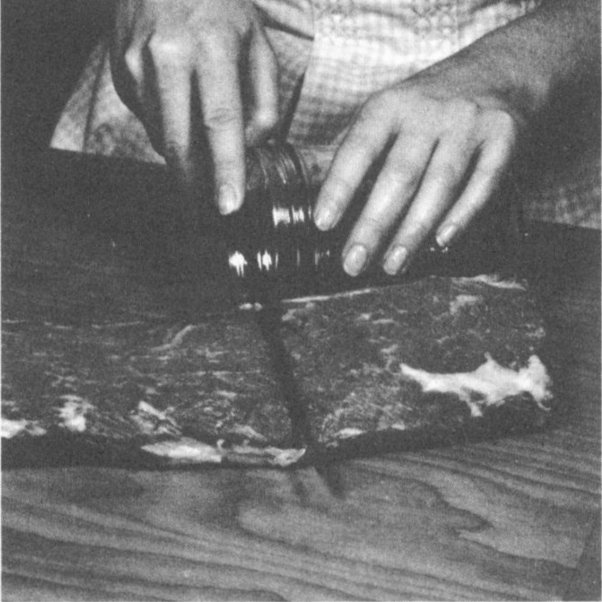
PN-1312
2. Cut meat in jar-length pieces, so grain of
meat runs length of jar. Fill jars to 1 inch of
top with one or more pieces of meat.
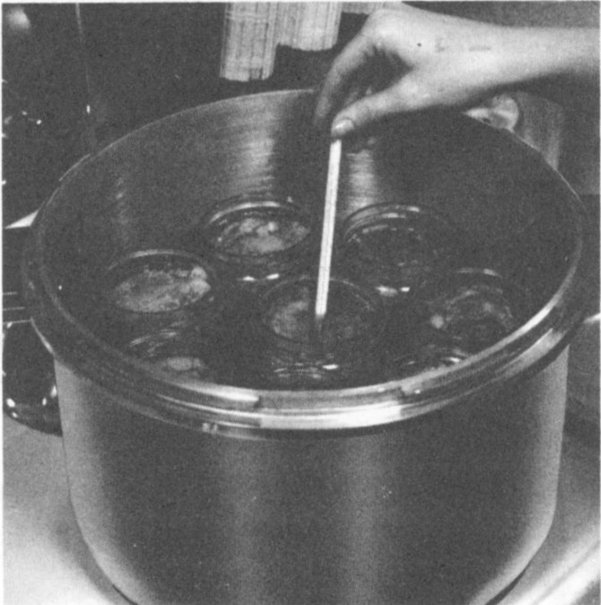
PN-1313
3. Set open, filled jars on rack in pan of
boiling water. Keep water level 2 inches
below jar tops. Insert thermometer in center
of a jar (above), cover pan, and heat meat
slowly to 170° F. Without thermometer,
cover pan; heat slowly for 75 minutes.
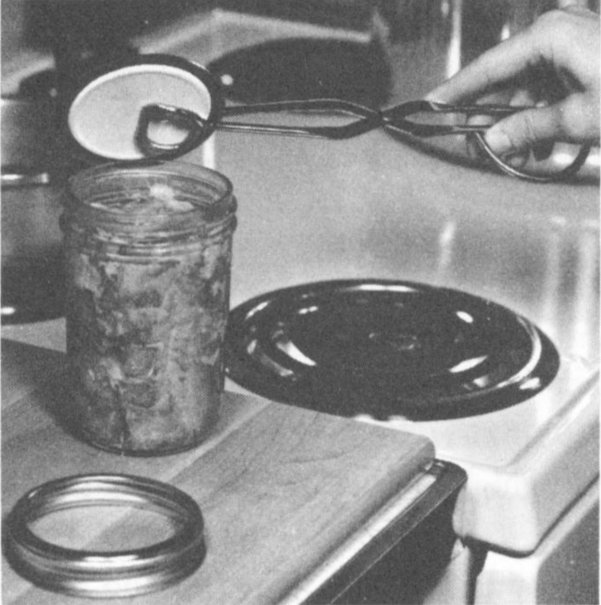
PN-1314
4. Remove jars from pan. Add salt if desired.
Wipe jar rim clean. Place lid so that sealing
compound is next to glass (above). Screw
the metal band down tight by hand. When
band is screwed tight, this lid has enough
“give” to let air escape during processing.
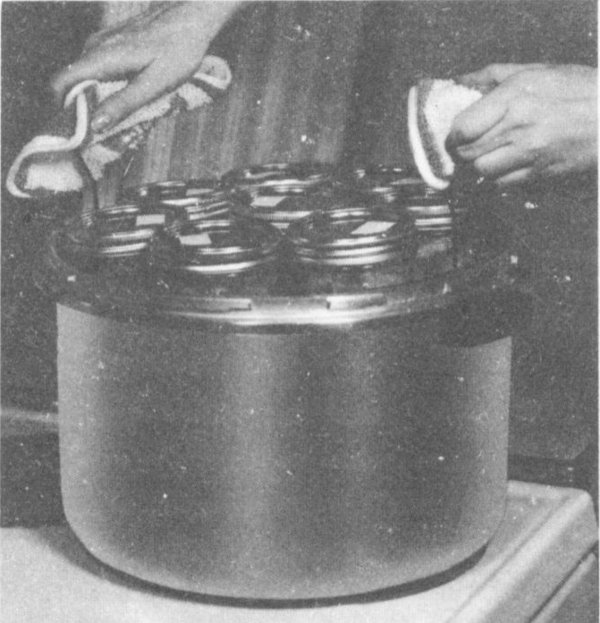
PN-1315
5. Have 2 or 3 inches of boiling water in pressure
canner—enough to keep it from boiling
dry during processing. Put jars in canner
(above), fasten cover. Let steam pour from
open petcock or weighted-gage opening 10
minutes. Shut petcock or put on gage.
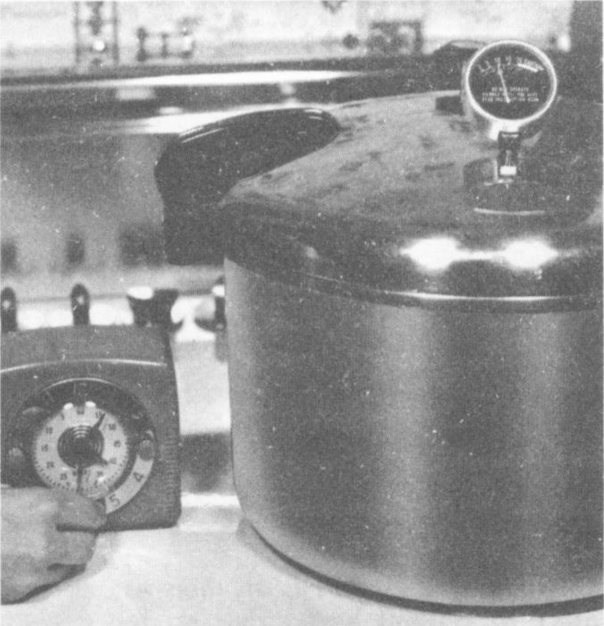
PN-1316
6. When pressure reaches 10 pounds, note
time. Adjust heat under canner to keep
pressure steady. Process pint jars packed
with large pieces of meat 75 minutes; process
quart jars 90 minutes. When processing
time is up, slide canner away from heat.
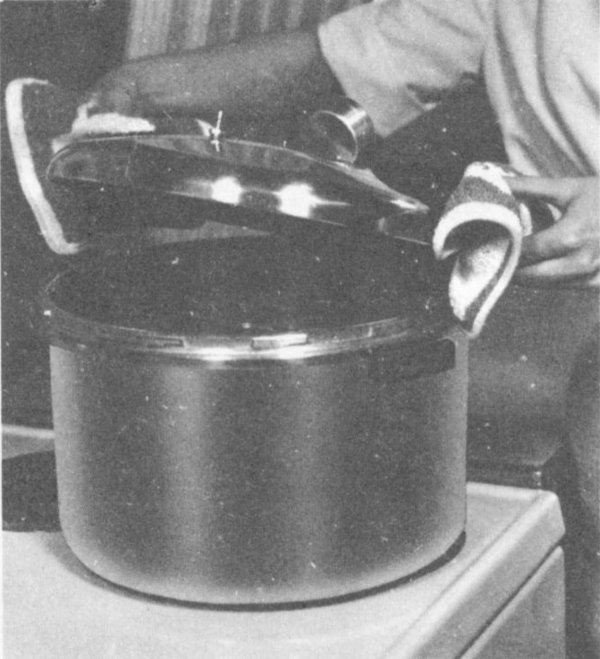
PN-1317
7. Let pressure fall to zero (30 minutes).
Wait a minute or two, then slowly open petcock.
Unfasten cover, tilting far side up to
keep steam away from your face.
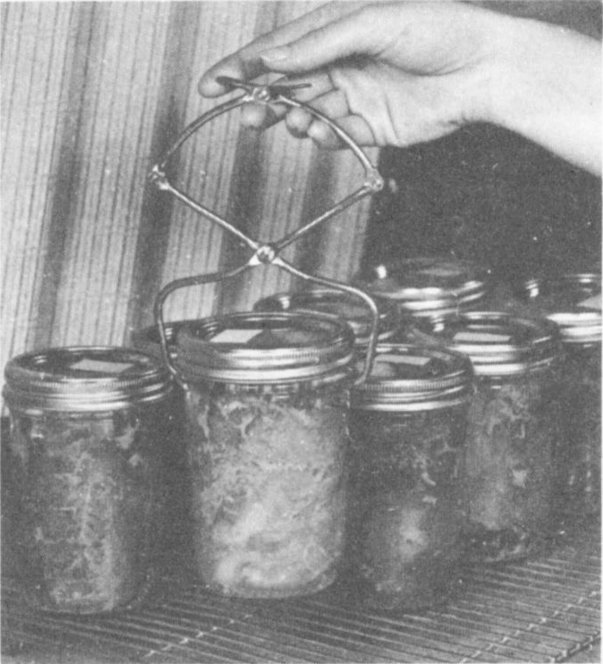
PN-1318
8. Set jars on rock to cool overnight. Keep
them away from drafts, but do not cover.
When jars are thoroughly cool, remove metal
bands and wipe jars clean. Label and store.
Directions for canning cut-up meat by hot-pack and raw-pack methods begin on page 18.

PN-1310
1. Rinse and drain (p. 4), then use a sharp
knife to disjoint bird. Pull on leg or wing
as you cut through the joint.
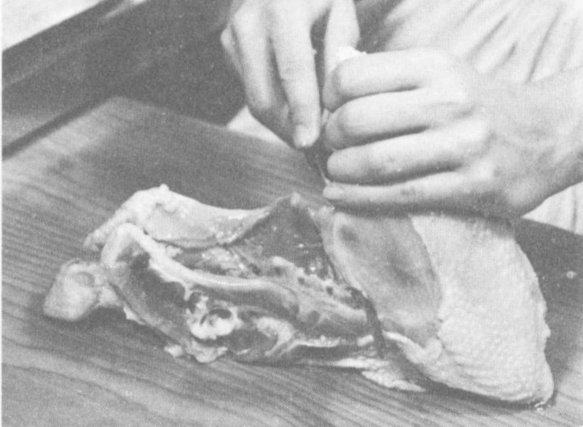
PN-1320
2. Cut from end of breastbone to backbone
along ends of ribs. Separate breast and
back. Break backbone; cut back in half.

PN-1321
3. Cut breast straight down between wishbone
and point of breast. Leave meat on wishbone.
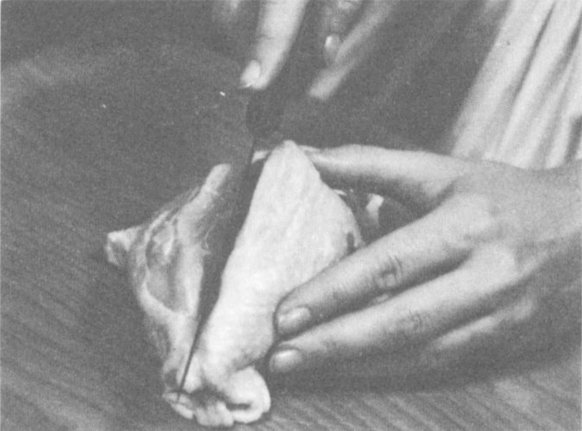
PN-1322
4. Remove breast meat from center bone by
carving down the bone on one side of breast.
Repeat on other side of breastbone.
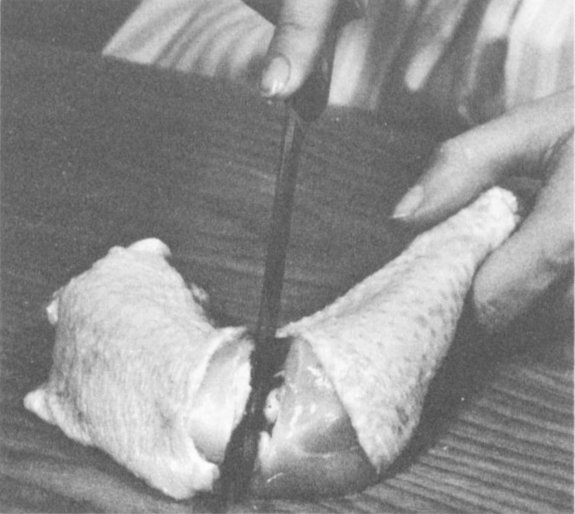
PN-1323
5. Cut legs into drumsticks and thighs. Saw
drumsticks off short, if desired. Sort into
meaty and bony pieces; set aside giblets to
can separately.
6. Pour enough hot water or broth (p. 8) over raw meaty pieces in pan to cover meat. Put on lid; precook meat to medium done (when cut at center, pieces show almost no pink color).
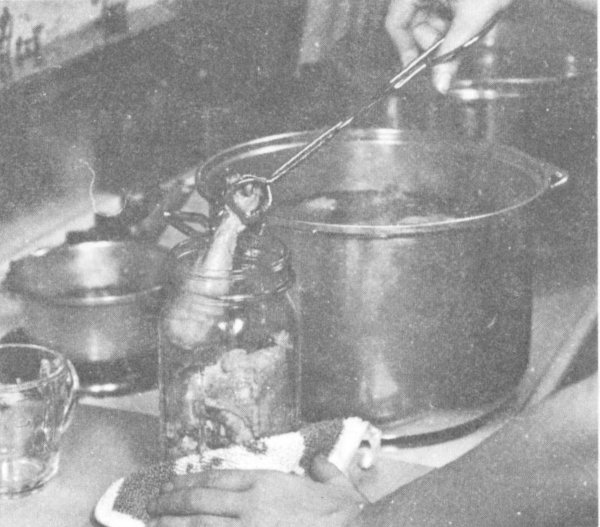
PN-1324
7. Pack hot chicken loosely into
jars. Place thighs and drumsticks
with skin next to glass; breasts in
center of jar; smaller pieces fitted
in. Leave 1 inch at the top of
jar. Add salt, if desired. Cover
chicken with boiling broth.
Again leave 1 inch of space at
top of jar.
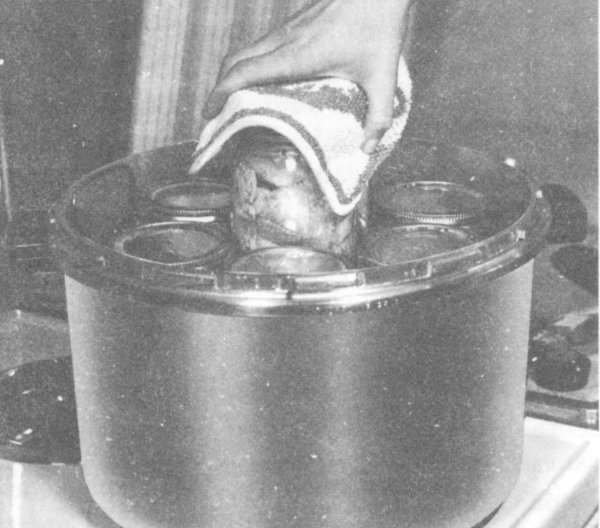
PN-1325
8. Wipe jar rim clean. Place lid
with sealing compound next to
glass. Screw metal band tight.
Have 2 or 3 inches of boiling
water in pressure canner to prevent
it from boiling dry during processing.
Place jars in canner (left)
and fasten lid securely. Let
steam pour from open petcock or
weighted-gage opening for 10
minutes. Then shut petcock or
put on weighted gage.

PN-1326
9. When pressure is 10 pounds,
note time. Adjust heat to keep
pressure steady. Process pint jars
of chicken with bone 65 minutes;
quarts, 75 minutes. Slide canner
off heat when time is up. Let
pressure fall to zero (about 30
minutes). Wait a minute or two.
Open petcock slowly. Unfasten
cover, tilting far side up to keep
steam away from your face. Cool
jars overnight. Wipe clean; label
(left). Before storing canned
chicken, remove screw bands.
Directions for canning poultry by hot-pack and raw-pack methods begin on page 21.
Directions for canning cut-up meat may be used for beef, veal, pork, lamb, and mutton. Meat from large-game animals may be canned by the same directions.
Use tender meat—loin and cuts suitable for roasts, steaks, and chops—for canning as large pieces. Use less tender cuts that contain more connective tissue and small pieces for canning as stew meat or ground meat. Use bony pieces for soup.
Follow directions for cutting up meat (p. 14).
Cut tender meat into jar- or can-length strips. Strips should slide into jars or cans easily, with the grain of the meat running the length of the container. Strips may be any convenient thickness, from 1 or 2 inches to jar or can width.
Cut less tender meat into chunks or small pieces suitable for stew meat.
Small, tender pieces may be packed by themselves, with meat strips, or with stew meat.
Put meat in large shallow pan; add just enough water to keep from sticking. Cover pan. Precook meat slowly until medium done. Stir occasionally, so meat heats evenly.
Glass jars.—Pack hot meat loosely. Leave 1 inch of space at top of jars. Add salt if desired: ½ teaspoon to pints or 1 teaspoon to quarts.
Cover meat with boiling meat juice, adding boiling water if needed. Leave 1 inch of space at top of jars. Adjust lids. Process in a pressure canner at 10 pounds pressure (240° F.)—
| Pint jars | 75 minutes |
| Quart jars | 90 minutes |
Tin cans.—Pack hot meat loosely. Leave ½ inch of space above meat. Add salt if desired: ½ teaspoon to No. 2 cans or ¾ teaspoon to No. 2½ cans. Fill cans to top with boiling meat juice, adding boiling water if needed. Seal. Process in a pressure canner at 10 pounds pressure (240° F.)—
| No. 2 cans | 65 minutes |
| No. 2½ cans | 90 minutes |
Cut up meat (p. 14). Pack containers loosely with raw, lean meat.
Glass jars.—Leave 1 inch of space above meat. To exhaust air, cook raw meat in jars at slow boil to 170° F., or until medium done (about 75 minutes). (See p. 9.) Add salt if desired: ½ teaspoon per pint or 1 teaspoon per quart. Adjust lids. Process in a pressure canner at 10 pounds pressure (240° F.)—
| Pint jars | 75 minutes |
| Quart jars | 90 minutes |
Tin cans.—Pack tin cans to top. To exhaust air, cook raw meat in cans at slow boil to 170° F., or until medium 19 done (about 50 minutes). (See p. 9.) Press meat down ½ inch below rim, and add boiling water to fill to top, if needed. Add salt if desired: ½ teaspoon to No. 2 cans or ¾ teaspoon to No. 2½ cans. Seal cans. Process in a pressure canner at 10 pounds pressure (240° F.)—
| No. 2 cans | 65 minutes |
| No. 2½ cans | 90 minutes |
For grinding, start with fresh, clean, cold meat. Use small pieces of meat from less tender cuts.
Never mix leftover scraps with fresh meat. Don’t use lumps of fat.
If desired, add 1 level teaspoon of salt per pound of ground meat. Mix well.
Shape ground meat into fairly thin patties that can be packed into jars or cans without breaking.
Precook patties in slow oven (325° F.) until medium done. (When cut at center, patties show almost no red color.) Skim fat off drippings; do not use fat in canning.
Glass jars.—Pack patties, leaving 1 inch of space above meat. Cover with boiling meat juice to 1 inch of top of jars. Adjust jar lids. Process in a pressure canner at 10 pounds pressure (240° F.)—
| Pint jars | 75 minutes |
| Quart jars | 90 minutes |
Tin cans.—Pack patties to ½ inch of top of cans. Cover with boiling meat juice to fill cans to top; seal.
Process in a pressure canner at 10 pounds pressure (240° F.)—
| No. 2 cans | 65 minutes |
| No. 2½ cans | 90 minutes |
Raw pack is suitable for tin cans. Ground meat canned in bulk is difficult to get out of jars.
Tin cans.—Pack raw ground meat solidly to the top of the can. To exhaust air, cook meat at slow boil to 170° F., or until medium done (about 75 minutes). (See p. 9.) Press meat down into cans ½ inch below rim. Seal. Process in a pressure canner at 10 pounds pressure (240° F.)—
| No. 2 cans | 100 minutes |
| No. 2½ cans | 135 minutes |
Use any tested sausage recipe.
Use seasonings sparingly because sausage changes flavor in canning and storage. Measure spices, onion, and garlic carefully. Omit sage—it makes canned sausage bitter.
Shape sausage meat into patties. Precook, pack, and process as directed for hot-packed ground meat.
Use any tested recipe to make corned beef.
Wash corned beef. Drain. Cut in pieces or strips that fit in containers.
Cover meat with cold water and bring to a boil. If broth is very 20 salty, drain meat; boil again in fresh water. Pack while hot.
Glass jars.—Leave 1 inch of space above meat. Cover meat with boiling broth or boiling water. Leave 1 inch of space at top of jars. Adjust lids. Process in a pressure canner at 10 pounds pressure (240° F.)—
| Pint jars | 75 minutes |
| Quart jars | 90 minutes |
Tin cans.—Leave ½ inch of space above meat. Fill cans to top with boiling broth or boiling water. Seal. Process in a pressure canner at 10 pounds pressure (240° F.)—
| No. 2 cans | 65 minutes |
| No. 2½ cans | 90 minutes |
| Beef, lamb, or veal, cut in 1½-inch cubes. | 2 quarts |
| Potatoes, pared or scraped, cut in ½-inch cubes | 2 quarts |
| Carrots, pared or scraped, cut in ½-inch cubes | 2 quarts |
| Celery, ¼-inch pieces | 3 cups |
| Onions, small whole, peeled | 7 cups |
Combine ingredients. Yield is 7 quarts or 16 pints.
Glass jars.—Fill jars to top with raw meat-vegetable mixture. Add salt if desired: ½ teaspoon per pint or 1 teaspoon per quart. Adjust lids. Process in a pressure canner at 10 pounds pressure (240° F.)—
| Pint jars | 60 minutes |
| Quart jars | 75 minutes |
Tin cans.—Fill cans to top with raw meat-vegetable mixture. Do not add liquid. Add salt if desired: ½ teaspoon to No. 2 cans or 1 teaspoon to No. 2½ cans. To exhaust air, cook stew at slow boil to 170° F., or until medium done (about 50 minutes). (See p. 9.) Seal cans. Process in a pressure canner at 10 pounds pressure (240° F.)—
| No. 2 cans | 40 minutes |
| No. 2½ cans | 45 minutes |
Heart and tongue usually are served as fresh meat. To can, prepare as described below; then follow hot pack directions (p. 18).
Heart.—Remove thick connective tissue before cutting into pieces.
Tongue.—Drop tongue into boiling water and simmer about 45 minutes, or until skin can be removed. Then cut into pieces.
For canning, make meat stock fairly concentrated. Cover bony pieces of meat (or chicken) with lightly salted water. Simmer until tender.
Skim off fat. Remove all bones. Leave meat and sediment in stock.
Glass jars.—Pour boiling soup stock into jars, leaving 1 inch of space at top. Adjust lids. Process in a pressure canner at 10 pounds pressure (240° F.)—
| Pint jars | 20 minutes |
| Quart jars | 25 minutes |
Tin cans.—Fill cans to top with boiling soup stock. Seal. Process in a pressure canner at 10 pounds pressure (240° F.)—
| No. 2 cans | 20 minutes |
| No. 2½ cans | 25 minutes |
Directions for poultry may be used to can chicken, duck, goose, guinea, squab, and turkey. These directions also apply to game birds.
Domestic rabbits and small-game animals should be canned like poultry.
Poultry, rabbits, and small-game animals may be canned with or without bone.
To make soup stock from poultry for canning, follow directions for meat.
Follow directions for cutting up poultry (p. 16). Sort into meaty and bony pieces. Use bony pieces for broth (p. 8) or soup (p. 20). Set aside giblets to can separately.
Bone breast. Saw drumsticks off short. Leave bone in other meaty pieces. Trim off large lumps of fat.
Place raw meaty pieces in pan and cover with hot broth or water. Put on lid. Heat, stirring occasionally until medium done. To test, cut piece at center; if pink color is almost gone, meat is medium done.
Pack poultry loosely. Place thighs and drumsticks with skin next to glass or tin. Fit breasts into center and small pieces where needed.
Glass jars.—Pack jars, leaving 1 inch of space above poultry. Add salt if desired: ½ teaspoon per pint or 1 teaspoon per quart. Cover poultry with boiling broth, leaving 1 inch of space at top of jar. Adjust jar lids. Process in pressure canner at 10 pounds pressure (240° F.)—
| Pint jars | 65 minutes |
| Quart jars | 75 minutes |
Tin cans.—Pack cans, leaving ½ inch of space above poultry. Add salt if desired: ½ teaspoon to No. 2 cans or ¾ teaspoon to No. 2½ cans. Fill cans to top with boiling broth. Seal. Process in a pressure canner at 10 pounds pressure (240° F.)—
| No. 2 cans | 55 minutes |
| No. 2½ cans | 75 minutes |
Cut up poultry (p. 16). Remove bone—but not skin—from meaty pieces either before or after precooking.
Glass jars.—Pack jars loosely with hot poultry, leaving 1 inch of space above poultry at top of jars. Add salt if desired: ½ teaspoon per pint or 1 teaspoon per quart. Pour in boiling broth; leave 1 inch of space at top of jar. Adjust jar lids. Process in a pressure canner at 10 pounds pressure (240° F.)—
| Pint jars | 75 minutes |
| Quart jars | 90 minutes |
Tin cans.—Pack loosely, leaving ½ inch above poultry. Add salt if desired: ½ teaspoon to No. 2 cans or ¾ teaspoon to No. 2½ cans. Fill cans to top with boiling broth. Seal. 22 Process in a pressure canner at 10 pounds pressure (240° F.)—
| No. 2 cans | 65 minutes |
| No. 2½ cans | 90 minutes |
Cut up poultry (see p. 16).
Bone breast. Saw drumsticks off short. Leave bone in other meaty pieces. Trim off large lumps of fat.
Pack raw poultry loosely. Place thighs and drumsticks with skin next to glass or tin. Fit breasts into center and small pieces where needed.
Glass jars (air exhausted).—Pack jars to 1 inch of top. To exhaust air, cook raw poultry in jars at slow boil to 170° F., or until medium done (about 75 minutes). (See p. 9.) Add salt if desired: ½ teaspoon per pint or 1 teaspoon per quart. Adjust lids. Process in a pressure canner at 10 pounds pressure (240° F.)—
| Pint jars | 65 minutes |
| Quart jars | 75 minutes |
Glass jars (air not exhausted).—Fill jars loosely with raw pieces of poultry to 1 inch of top. Do not exhaust. Add salt if desired: ½ teaspoon per pint or 1 teaspoon per quart. Adjust lids. Process in a pressure canner at 10 pounds pressure (240° F.)—
| Quart jars | 80 minutes |
Tin cans.—Pack cans to top. To exhaust air, cook raw poultry in cans at slow boil to 170° F., or until medium done (about 50 minutes). (See p. 9.) Add salt if desired: ½ teaspoon to No. 2 cans or ¾ teaspoon to No. 2½ cans. Seal cans. Process in a pressure canner at 10 pounds pressure (240° F.)—
| No. 2 cans | 55 minutes |
| No. 2½ cans | 75 minutes |
Cut up poultry (p. 16). Remove bone—but not skin—from meaty pieces before packing containers.
Glass jars.—Pack raw poultry in jars to 1 inch of top. To exhaust air, cook poultry in jars at slow boil to 170° F., or until medium done (about 75 minutes). (See p. 9.) Add salt if desired: ½ teaspoon per pint or 1 teaspoon per quart. Adjust lids. Process in a pressure canner at 10 pounds pressure (240° F.)—
| Pint jars | 75 minutes |
| Quart jars | 90 minutes |
Tin cans.—Pack raw poultry to top of cans. To exhaust air, cook poultry in cans at slow boil to 170° F., or until medium done (about 50 minutes). (See p. 9.) Add salt if desired: ½ teaspoon to No. 2 cans or ¾ teaspoon to No. 2½ cans. Seal cans. Process in a pressure canner at 10 pounds pressure (240° F.)—
| No. 2 cans | 65 minutes |
| No. 2½ cans | 90 minutes |
Use pint jars or No. 2 cans.
Wash and drain giblets.
Pack gizzards and hearts together. Precook and pack livers separately to avoid blending of flavors.
Put giblets in pan; cover with hot broth or hot water. Cover pan and precook giblets until medium done. Stir occasionally. Pack hot.
Glass jars.—Leave 1 inch of space above giblets. Add boiling broth or boiling water, leaving 1 inch of space below jar tops. Adjust lids. Process in a pressure canner at 10 pounds pressure (240° F)—
| Pint jars | 75 minutes |
Tin cans.—Leave one-half inch of space above giblets. Fill cans to top with boiling broth or boiling water. Seal. Process in a pressure canner at 10 pounds pressure (240° F.)—
| No. 2 cans | 65 minutes |
Q. Why must a pressure canner be used for canning meat and poultry?
A. To insure a safe product. It takes a combination of high temperature and sufficient processing time to make sure of killing bacteria that cause dangerous spoilage in canned meat and poultry. The only practical way to get the necessary high temperature is to use a pressure canner.
Q. How should meat and poultry for canning be handled?
A. Keep meat and poultry clean and sanitary. Chill at once and keep cold until canning time. (See p. 4.)
Q. Why is liquid sometimes lost from glass jars during processing?
A. Loss of liquid may be due to packing jars too full, fluctuating pressure in a pressure canner, or lowering pressure too suddenly.
Q. Should liquid lost during processing be replaced?
A. Loss of liquid does not cause meat to spoil, although the meat above the liquid may darken. Never open a jar and refill with liquid—this would let in bacteria and meat would have to be processed again.
Q. Is it safe to can meat and poultry without salt?
A. Yes. Salt is used for flavor only and is not necessary for safe processing.
Q. Is it safe to leave food in tin cans after opening?
A. Yes. Food in tin cans needs only to be covered and refrigerated.
Q. Is it all right to use preservatives in home canning?
A. No. Some canning powders or other chemical preservatives may be harmful.
Q. Should processing times be changed for different types of ranges?
A. No. Processing times and temperatures given in this bulletin are for canning in a pressure canner and may be used for any type of range.
Q. Is it possible to can frozen meat or poultry?
A. Yes, frozen meat or poultry may be canned. (For directions, see p. 4.)
A B C D E F G H I J K L M N O P Q R S T U V W X Y Z
Publications of the Agricultural Research Service listed below may help you if you want to preserve food at home. Single copies may be obtained free by sending a post card to the Office of Communication, U.S. Department of Agriculture, Washington, D.C., 20250. Please order by title and number of publication. Include your ZIP Code.
| Order No. | |
|---|---|
| Home Canning of Fruits and Vegetables | G 8 |
| Home Freezing of Fruits and Vegetables | G 10 |
| Freezing Combination Main Dishes | G 40 |
| How To Make Jellies, Jams, and Preserves at Home | G 56 |
| Home Freezing of Poultry | G 70 |
| Making Pickles and Relishes at Home | G 92 |
| Freezing Meat and Fish in the Home | G 93 |
U.S. GOVERNMENT PRINTING OFFICE: 1973—O-509-159